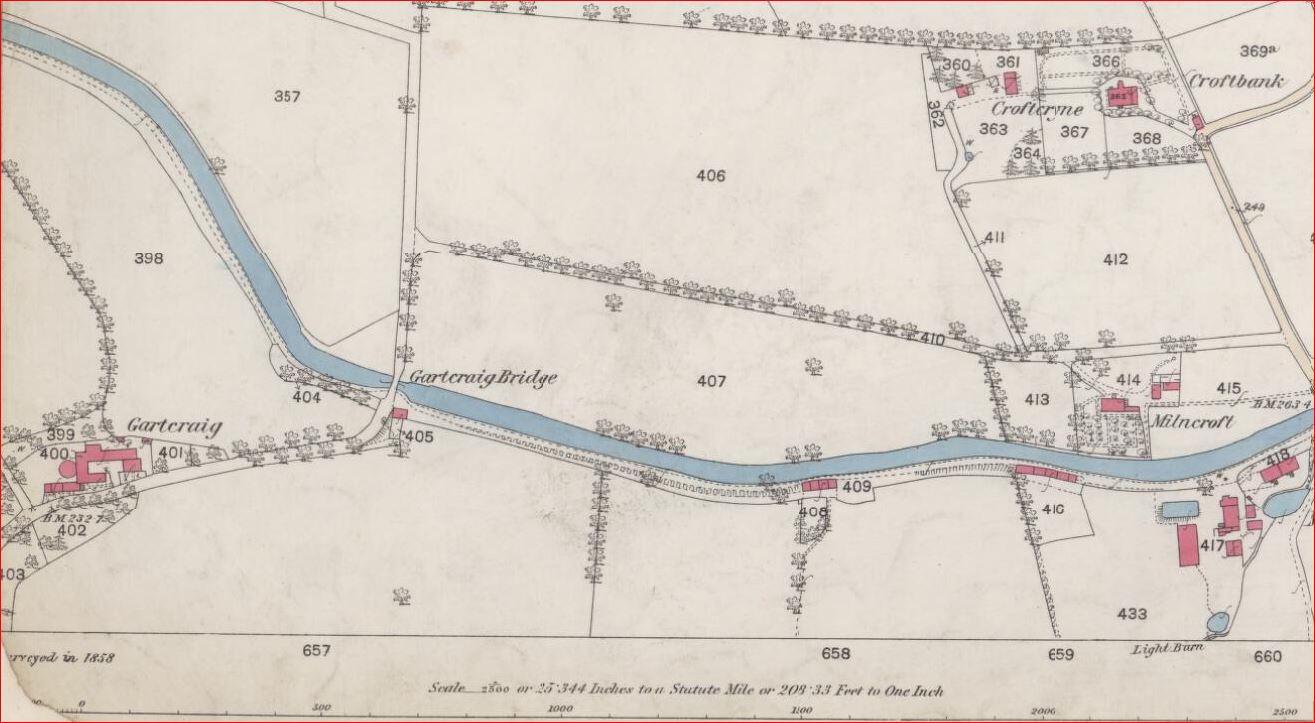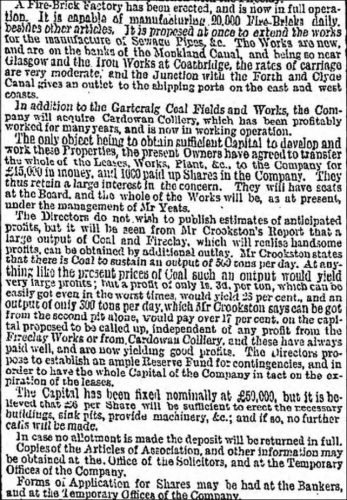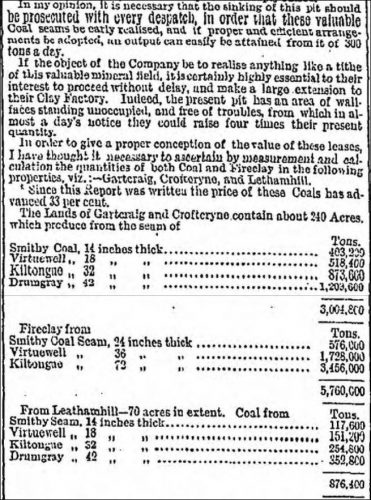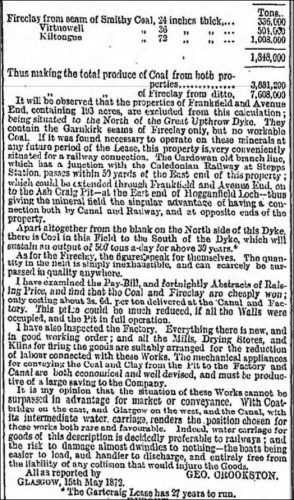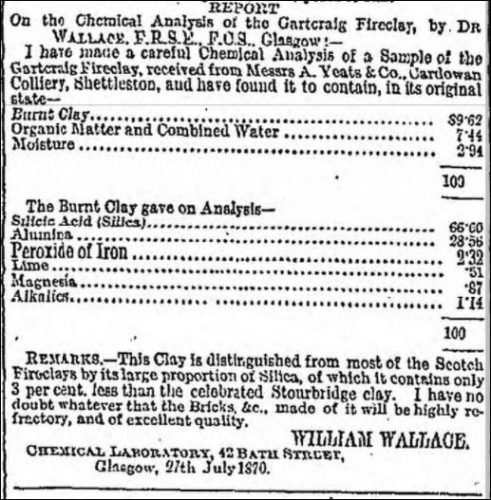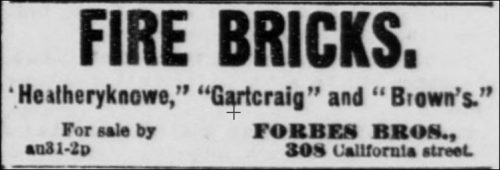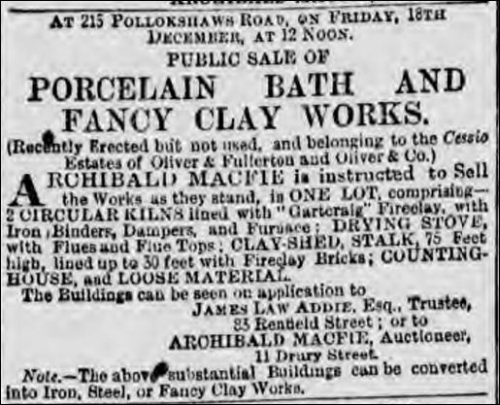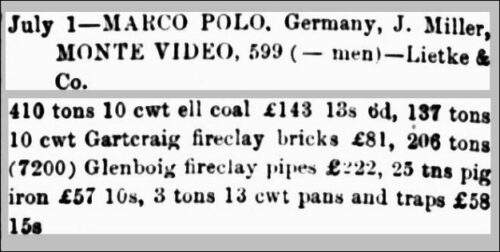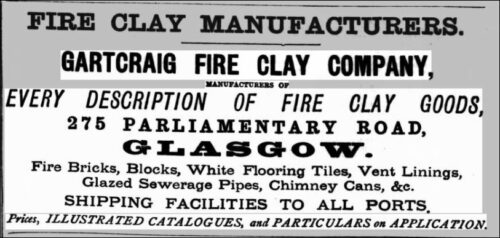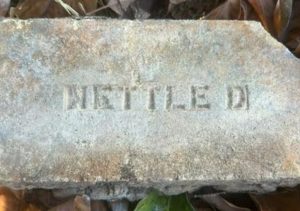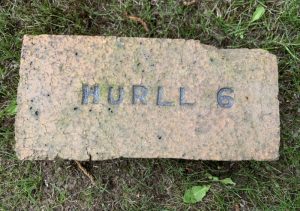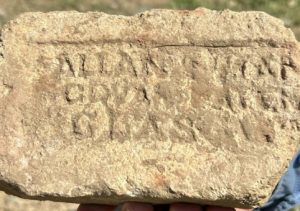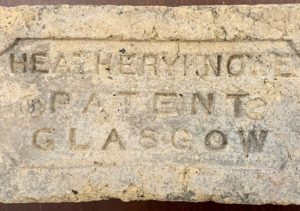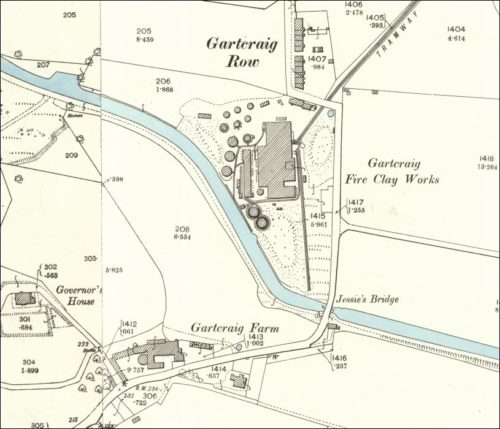
1897 – 1898 – Gartcraig Fire-Clay Co. makers of white and coloured enamelled bricks, white facing bricks, sewerage pipes, and all kinds of fire-clay goods, 18 Charles st St. Rollox; depot, Monkland Canal basin; works, Gartcraig, by Shettleston; telegraphic address, “Gartcraig;” telephone No. 1299.
14/05/1898 – Glasgow Herald – Cast iron plates for sale. 164, 1/2″ thick – different sizes – Gartcraig Brickworks by Shettleston.
26/11/1898 – Dundee Courier – New joint stock companies – Gartcraig Fire Clay Company – to acquire the business of fire brick and tile makers and coal owners at present carried on by the Gartcraig Fire Clay Company at Shettleston near Glasgow. Capital £15,000 in 2500 shares of £6 each.
1901 – Directory of clay workers – Gartcraig Fire Clay Company Limited, 18 Charles Street, St. Rollox, Glasgow. Enamelled, vitrified, facing, pressed and fire bricks, sewerage pipes, fire clay goods. T. add Gartcraig Glasgow. Tel 1299.
1901 – 1902 – Gartcraig Fire-Clay Co. Ltd. makers of white and coloured enamelled bricks, double-dipped vitrified bricks, facing bricks, fire bricks, sewerage pipes, chimney cans, and all kinds of fire-clay goods, 18 Charles St., St. Rollox; depot, Monkland Canal basin, Castle Street; works, Gartcraig, by Millerston; telegraphic address, ” Gartcraig; ” telephone No. 1299.
20/03/1901 – Kirkintilloch Herald – Wanted. Miners to keep away from Glenboig, Gartliston, Gartcosh and Heathfield Fireclay Pits during the present dispute.
05/04/1901 – Edinburgh Gazette – Sequestration of Robert Porter, builder, Bellshill, Glasgow … P. Wylie Rodger, secretary of the Gartcraig Fireclay Company Limited, Saint Rollox, Glasgow is appointed one of the commissioners.
10/05/1901 – West Lothian Courier – A gathering of the employees of the Gartcraig Fire Clay Company Ltd, Millerston was held in Mr Baxters ‘The Auld Hoose’ 455 Gallowgate, Glasgow on Saturday evening the 4th of May to present Mr Alex Scott, foreman of the works, with a handsome timepiece on his leaving to fulfil a more lucrative appointment. Mr McGlen made the presentation which Mr Scott suitably replied.
12/08/1901 – The Scotsman – The Glasgow International exhibition … Gartcraig Fire Clay Company exhibit similar to the Glenboig Union Fireclay Company (fire bricks, furnace blocks and gas retorts) with chimney cans and vases.
26/07/1902 – The Western Australian. The federal tariff (tax), official decisions – Firebricks marked Gartcraig – 15%.
1904 – 1905 – Gartcraig Fire-Clay Co. Ltd. makers of white and coloured enamelled bricks, double-dipped vitrified bricks, facing bricks, fire bricks, sewerage pipes, chimney cans, ornamental vases, and all kinds of fire-clay goods, 18 Charles St, St Rollox; Depot, Monkland Canal basin, Castle Street; works, Gartcraig, by Millerston; telegraphic address, “Gartcraig ” telephone Nat. and Corp. Nos. 1299.
1905 – 1906 – Gartcraig Fire-Clay Co. Ltd. makers of white and coloured enamelled bricks, double-dipped vitrified bricks, facing bricks, fire bricks, sewerage pipes, chimney cans, ornamental vases, and all kinds of fire-clay goods, 18 Charles St, St Rollox; Depot, Monkland Canal basin, Castle Street; works, Gartcraig, by Millerston; telegraphic address, “Gartcraig ” telephone Nat. and Corp. Nos. 1299.
19/05/1905 – Kirkintilloch Herald – Football match. Hogganfield Bleaching and Finishing Company beat the Gartcraig Fireclay Workers 7-0.
05/07/1905 – Kirkintilloch Herald – New buildings … by the Gartcraig Fireclay Company Ltd, for addition to existing millshed at Gartcraig Fireclay Works, Millerston.
1906 – Memoirs of the geological survey. Summary of progress of the geological survey of Great Britain … A point of considerable interest has arisen about the identification of the coals worked, under the names of the Virtuewell and the Kiltongue, at Gartcraig Colliery, Millerston. Mr Swan, the Manager of Gartcraig Fireclay Works, has long suspected that the uppermost of these coals is the Kiltongue and that the other, known as the Kiltongue, is really some lower coal. The same opinion had previously been expressed by Messrs. McCreaths and Stevenson, to whom we are indebted for much of the evidence bearing on the question. In the first place, the distance of 29 fathoms between the coals just mentioned agrees with the distance between the Kiltongue and Balmoral seams at Lochwood Colliery, Commonhead, 3 miles east of Gartcraig, and is far too large for the average distance between the Virtuewell and Kiltongue in the district.
A massive sandstone from three to four fathoms thick above the so-called Virtuewell coal at Gartcraig corresponds very well with that commonly found above the Kiltongue seam, and the sandstone above the true Virtuewell never seems to attain this thickness in the neighbourhood.
Mr James McCreath remembers having seen debris of mussel band in the tip of Gartcraig shaft before it had been sunk as far as the so-called Virtuewell coal, and he thinks that it probably came from the well-known mussel band about nine fathoms above the Kiltongue seam. The lower coal at Gartcraig closely resembles the coal to which a shaft has been recently sunk at Lochwood Colliery, Commonhead. The chief point of resemblance is the occurrence of a brown-stone rib in the body of the coal. The Lochwood coal is 28¼ fathoms below the Kiltongue. It is called the Balmoral by the Lochwood Coal Company.
Mr Dunn, of Wester Daldowie, thinks, however, that this coal, which is characterized by a brown-stone rib, is the Armadale or Bathgate Main coal. He states that this coal is everywhere characterized by the same stone rib or ribs, and he regards it as equivalent to the Brightons Main at Falkirk, and the Kilsnachtan Main at Alloa.
1907 – Gartcraig Fire Clay Co. Ltd, 18 Charles St., St. Rollox; Depot, Monkland Canal basin, Garngad Hill.
1907 – 1908 – Gartcraig Fireclay Co., Ltd., 18 Charles street, St. Rollox. Tel./Add. ” Gartcraig, Glasgow”.
1908 – 1909 – Gartcraig Fireclay Co., Ltd., 18 Charles street, St. Rollox. Tel./Add. ” Gartcraig, Glasgow”.
31/10/1908 – Kalgoorlie Miner – Lancefield Gold Mining Co … In figuring on the remodelling of the roasters we considered we were making sufficient provision for safety in improving on the ordinary bricks in the crowns by putting in Statham firebricks. This Mr Bigelow still further improves on by recommending that the crowns should be of the best Gartcraig firebricks. We entirely approve of this course but are prohibited from adopting it unless with a further expenditure of money.
Below – 1910 – Gartcraig Fire Clay Works. (The 1935 map does not detail the brickworks).
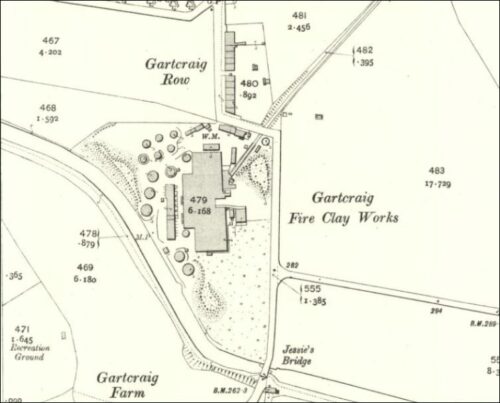
1910 – The housing conditions of miners” by Dr John T. Wilson. Gartcraig Fire Clay Co., Ltd, Millerston.
Gartcraig Fire Clay Mine – Situated near Shettleston
Persons employed – underground – 80, above ground – 8, Total – 88
The workmen reside mostly in rented houses at Shettleston or at Hogganfield, and in 12 houses situated on Gartcraig Estate. Three of these have two rooms and a kitchen, seven have one room and kitchen, and two are single apartments.
The 12 houses are described as follows:-
Erected about 40 years ago – One storey, built of brick – no damp-proof course – Wood or tile floors, wood floors ventilated – internal surface of walls and ceilings in good condition
- No overcrowding – apartments large
- No gardens, but have common wash house and coal cellars
- Gravitation water from a standpipe
- Privy middens about 20 yards in rear of houses
- Drainage by surface channels
- Scavenged at owners’ expense
- Repairs have been carried out
1918 – Gartcraig Fire Clay Co. Ltd., Gartcraig Works, Millerston, Glasgow. Mine is named Gartcraig and located at Shettleston. Manager – Thomas Scobie Under – Manager Robert Reid. 40 persons worked below ground and 8 above.
11/07/1919 – Kirkintilloch Gazette – At the district committee meeting it was reported that the Gartcraig Mine had been abandoned and steps were being taken to suitably protect the shafts.
Below – 06/08/1919 – The Scotsman – Sale at Gartcraig Colliery, Millerston on the instruction of the Gartcraig Fire Clay Co Ltd owing to the termination of the lease.

Below – 15/11/1919 – Gartcraig Fireclay Works for sale.
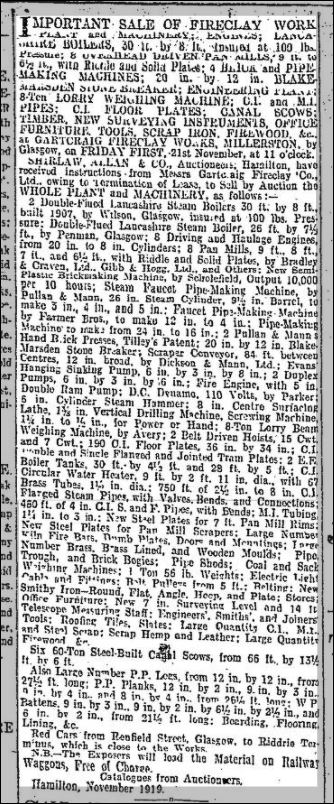
Below – 17/11/1919 – The Scotsman –
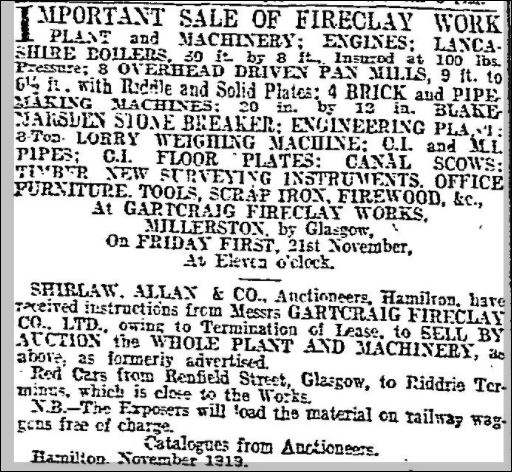
Below – 14/08/1920 – The Scotsman – Sale of equipment at Gartcraig Fire Clay Works, Millerston. Termination of the lease.
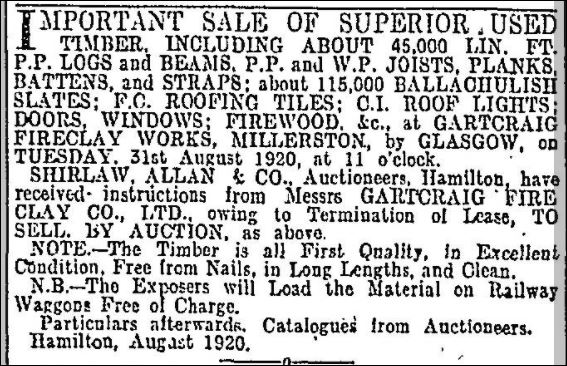
1921 – The Scottish Refractory Industry 1830 – 1980 by Kenneth W Sanderson – The Gartcraig Coal & Fireclay Company was voluntarily wound up in 1877 but reformed as Gartcraig Fireclay Co. Ltd., and continued to make firebricks up to 1921 when the works were closed. The brand Gartcraig was taken over by P & M Hurll Ltd. (Note – SBH – It sounds like the actually ‘Gartcraig’ brick stamp was continued by P & M Hurll but where did they make the Gartcraig branded bricks?).
Below – 1922 – A Textbook of fire assaying by Edward E. Bugbee, Assistant Professor of Mining Engineering and Metallurgy, Massachusetts Institute of Technology, USA … Chapter on ‘Furnaces and Furnaceroom Supplies”.
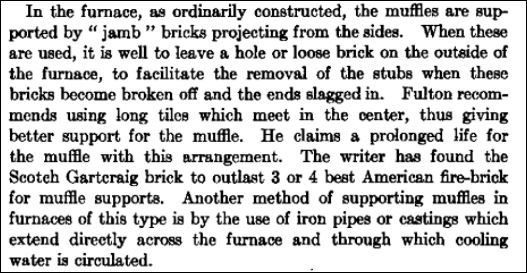
19/05/1922 – Edinburgh Gazette – Gartcraig Fireclay Company Limited. A petition has been presented to the Lords of Council and Session (First Division, Mr Paton, Clerk) by the Gartcraig Fireclay Company Limited, incorporated under the Companies Acts, 1862 to 1898, and having its registered office at 18 Charles Street, St. Rollox, Glasgow, praying their
Lordships to confirm the alteration of the provisions of the company’s memorandum of association with respect to its objects, set forth in a special resolution of the company passed on 11th March and confirmed on 1st April 1922, upon which Petition the Lords of the First Division have been pleased to pronounce the following Interlocutor:-Edinburgh, 11th May 1922. The Lords appoint the Petition to be intimated on the Walls and in the Minute-Book in common form, to be advertised once in the Edinburgh Gazette and once in each of the Scotsman and Glasgow Herald newspapers and allows all concerned to lodge answers thereto, if so advised, within eight days after such intimation and advertisement. J. A. Clyde, I.P.D.
Of all which intimation is hereby given. Dove, Lockhart, & Smart, S.S.C., petitioners’ agents, 29 York Place, Edinburgh,17th May 1922.
Below – 07/07/1922 – United States Patent Office
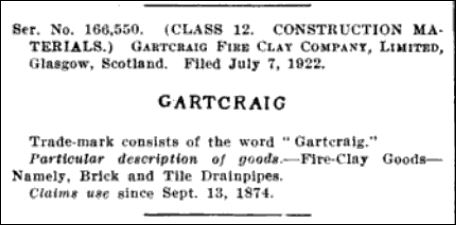
Below – 01/05/1923 – United States Patent Office – Gartcraig Trademark registered no 210067, in England 11/12/1897.
Registered May 1, 1923. Trade-Mark 167,576
United States Patent Office.
Gartcraig Fire Clay Company Limited of Glasgow, Scotland.
Act of February 20th 1905.
Application filed July 7, 1922. Serial No. 166,550
Gartcraig statement. To all whom it may concern: Be it known that we, Gartcraig Fire Clay Company Limited, a limited liability company organised under the laws of Great Britain and Ireland, and located and doing business at 18 Charles Street, St Rollox, Glasgow, Scotland, have adopted and used the trade-mark shown in the accompanying drawing, for fire clay goods – namely brick, tile and drain pipes in Class No. 12, construction materials. The trademark has been continually used in the business of the applicant since the 13th of September, 1874. The trademark is “affixed” to the goods by impressing the mark upon the goods themselves. The trademark consists of the word “Gartcraig”. Said trademark has been registered in England, No. 210,067, December 11, 1897. Chauncey P. Carter, of 4907 Potomac Avenue, Northwest, Washington, D. C., is the person designated as applicants representative on whom process or notice of proceedings affecting the right to ownership of said trademark brought under the laws of the United States may be served. Gartcraig Fire-Clay Company, Limited, P. Wylie Rodger. Secretary.
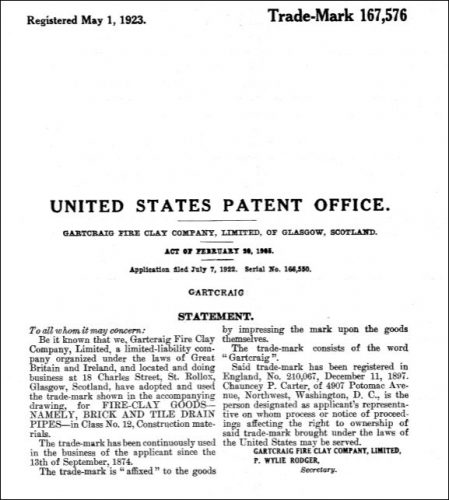
1930 – 1931 – Gartcraig Fire Clay Co. Ltd., makers of white and coloured enamelled bricks, double-dipped vitrified bricks, facing bricks, fire bricks, sewage pipes, chimney cans, ornamental vases and all kinds of fire-clay goods, 18 Charles St, St. Rollox, N; depot, Monkland Canal basin, Castle St., C.4; Telegraphic address ‘Gartcraig’. Telephones, 3400, 3401 and 3402 Bell.
Below – 1933 – Gartcraig playing fields on the site of the former Gartcraig Fire Clay Works.
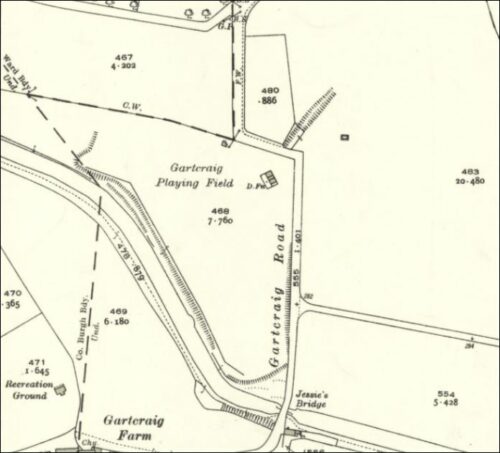
1936 – 1937 – Gartcraig Fire Clay Co. Ltd., makers of fire bricks, sewage pipes, chimney cans, and all kinds of fire-clay goods, 18 Charles St, St. Rollex, N; depot, Monkland Canal basin, Castle St., C.4; telephones, 3400 and 3401 Bell.
1936 – 1937 – P. Wylie Rodger of Gartcraig Fire Clay Company Ltd, Glasgow. House Southcourt, Helensburgh.
05/07/1938 – Edinburgh Gazette – The Companies Act, 1929. Special resolution of Galloway, Gibb & Co Ltd, passed 30th June 1938. At an extraordinary general meeting of the
members of the said company, after due notice specifying the intention to propose the following resolution as a special resolution had been given, held at the office of Messrs. Melville, Dundas & Whitson Ltd., 224 St. Vincent Street, Glasgow, in the County of the City of Glasgow, on the 30th day of June 1938, the following special resolution was duly passed:- ” That the company be wound up voluntarily and that Patrick Wylie Rodger, of Gartcraig Fire Clay Company Limited, 18 Charles Street, Glasgow, N, be and he is hereby appointed the liquidator for the purpose of such winding-up.
23/11/1951 – Motherwell Times – The ‘George’ Cinema Belshill. Architects – Messrs Gavin Paterson & Son. Another successful cinema front in Faience by Shaws. – Scottish agents – Gartcraig Fire Clay Co Ltd, 18 Charles Street, Glasgow. Shaws glazed brick Co Ltd, Whitebirk Works, Waterside nr Darwen, Lancs.
10/06/1960 – Edinburgh Gazette – Gartcraig Fireclay Company Limited. A petition has been presented by the above-named company which was incorporated under the Companies
Acts 1862 to 1900 and has its Registered Office at 18 Charles Street, Glasgow N.I, to the Court of Session setting form that the capital is in excess of the wants of the company and praying the court to confirm the reduction of capital to £3,750 divided into 2,500 Shares of £1 10/- each on which petition their Lordships of the First Division of the Court of Session have of date 7th June 1960 pronounced an interlocutor ordering intimation and advertisement as therein provided and allowing answers to be lodged within seven
days. Atken Methuen & Aikman, solicitors for petitioners, 37 Queen Street, Edinburgh. 8th June 1960.
18/10/1960 – Edinburgh Gazette – Gartcraig Fire Clay Company Limited. Notice is hereby given that in the petition presented by the above-named Company to the Court of Session for confirmation of reduction of capital an order of the court dated 12th October 1960 confirming the reduction of the share capital of the company as set forth in the petition and a
minute which has been approved by the Court were registered by the Registrar of Companies on 14th October 1960. Atken Methuen & Aikman, solicitors for petitioners, 37 Queen Street, Edinburgh. 17th October 1960.
10/04/1973 – Edinburgh Gazette – Annual return. Gartcraig Fireclay Company Limited.
29/03/1974 – Edinburgh Gazette – Particulars of directors or changes thereof – Gartcraig Fireclay Company Limited.
05/04/1974 – Annual return. Gartcraig Fireclay Company Limited.
04/01/1975 – Annual return. Gartcraig Fireclay Company Limited.
13/04/1976 – Edinburgh Gazette – Annual return. Gartcraig Fireclay Company Limited.
16/09/1977 – Edinburgh Gazette – Annual return. Gartcraig Fireclay Company Limited.
Below – History. Source Kenneth W Sanderson – Gartcraig Coal & Fireclay Co Ltd (later Gartcraig Fireclay Co Ltd) – The Gartcraig Coal & Fireclay Company Ltd was incorporated in 1872 to work the fireclays in Gartcraig, Croftcroighn, Frankfield, Avenue End, Lethamhill, Cardowan and Gartsheugh mineral leases, all to the East end of Glasgow. The capital was fixed at £50, 000 in £10 shares, a very large sum for those days, particularly as virtually all the subscriptions came from the Willis and Yeats families. George Willis, Physician of Clifton House, Baillieston, became the chairman and held 1617 of the 4253 shares taken up. Most of the balance was held by the Yeats family. The shares were paid up to the extent of £6 and the capital was scaled down to £34,000. George Willis and Andrew Yeats were both coalmasters in the Gartcraig and Cardowan Companies and partners in Andrew Yeats & Co Ltd.
The Gartcraig Coal & Fireclay Company was voluntarily wound up in 1877 but reformed as Gartcraig Fireclay Co. Ltd., and continued to make firebricks up to 1921 when the works were closed. The brand Gartcraig was taken over by P & M Hurll Ltd. The Gartcraig works site lay on the North Bank of the Monkland Canal, half a mile South of Hogganfield Loch, and was connected with a tramway to the Gartcraig Colliery which supplied the fireclay. The OS map of 1898 shows 6 large round kilns, 6 smaller round kilns and a battery of chambers, so it was a substantial producer of firebricks. The Gartcraig Fireclay Company appears as a small shareholder in James Dougall of Bonnybridge in 1927 and thereafter fades from history. (Note – SBH – This reference to Gartcraig Fireclay Co Ltd fading from sight c. 1927 is confusing as you will see from the information on this page that I have several references of the company up to 1951. K Sanderson also states that the Gartcraig Fireclay Company Limited was wound up in 1921 so how was the company a shareholder of James Dougall, fire brick manufacturers in 1927 ).
*************************************************
Gartcraig Fire Clay Co., Ltd, Millerston – Source
Gartcraig Fire Clay Mine – Situated near Shettleston
Persons employed – underground – 80, above ground – 8, Total – 88
The workmen reside mostly in rented houses at Shettleston or at Hogganfield, and in 12 houses situated on Gartcraig Estate. Three of these have two rooms and a kitchen, seven have one room and kitchen, and two are single apartments.
The 12 houses are described as follows:-
Erected about 40 years ago – One storey, built of brick – no damp-proof course – Wood or tile floors, wood floors ventilated – internal surface of walls and ceilings in good condition
- No overcrowding – apartments large
- No gardens, but have common wash house and coal cellars
- Gravitation water from a standpipe
- Privy middens about 20 yards in rear of houses
- Drainage by surface channels
- Scavenged at owners’ expense
- Repairs have been carried out
********************************************************
… The furnace is of the reverberatory type, built of Gartcraig fire-brick and black New Zealand fire-clay. The whole hearth is cased in J-in. iron plate tank, in case of the collapse of the fire-bricks, when the whole charge may be caught. There are three charging doors on one side, and one skimming door at the end of the furnace, and above the latter is a horizontal flue, connected with the underground refinery flue and stack. It is fitted with a hand-hole for cleaning … source
*******************************************************
Below – 1905 – Pair of Medici style stoneware (fireclay?) urns. A pair of stoneware urns after the antique medici vase, produced by the Gartcraig Fire Clay Company, marked “Gartcraig”, Scottish (Glasgow), circa 1905. On associated stoneware pedestals, marked “Doulton Lambeth”, English, circa 1900. 50 ins. overall height. Measures: Urn 29 ins. high, 21 ins. overall diameter; base 21 ins. high, 15 ins. square at bottom.

.
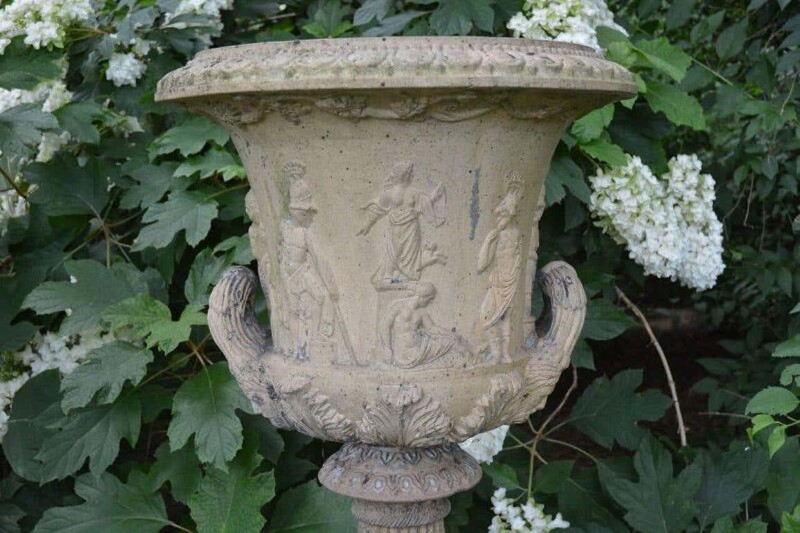
.
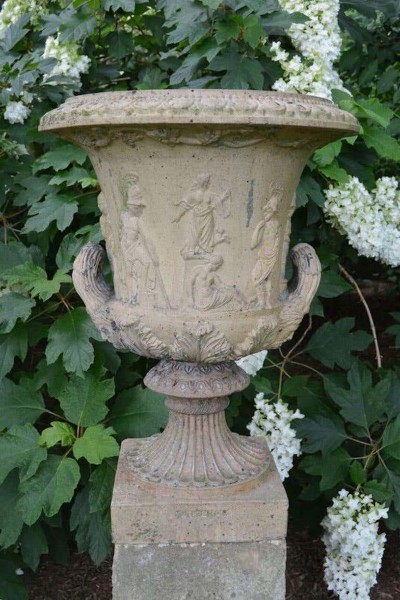
.
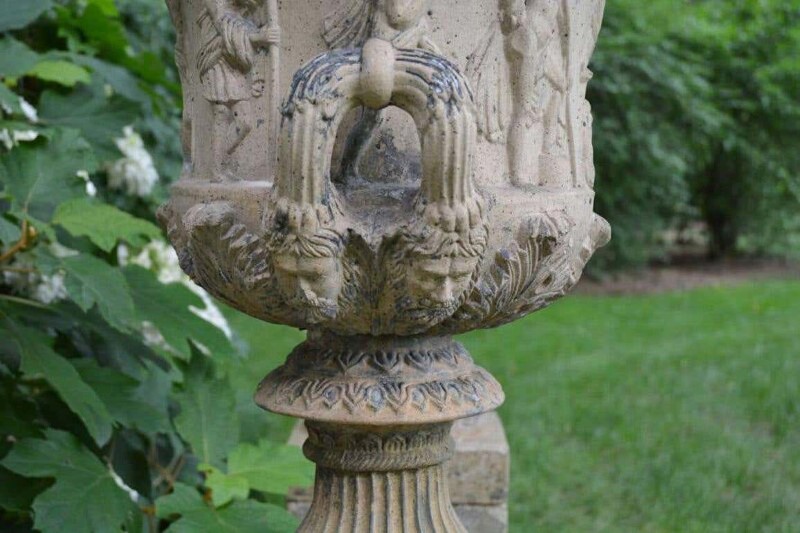
.



